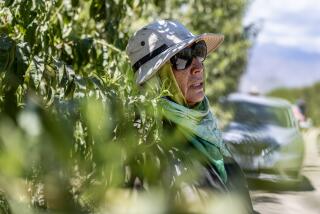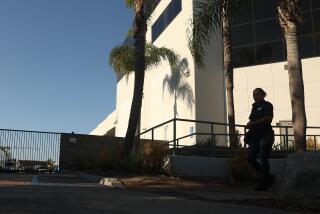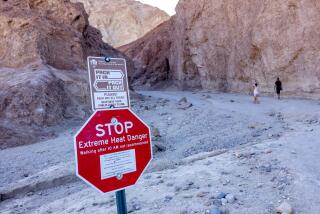Hot Under the Collar? Try Walking Around in a Mouse Suit : At Some Jobs, Misery Rises With the Mercury
- Share via
So you think it’s hot?
Just be glad you don’t have to stand on a hot tar roof, lifting heavy materials dozens of feet above the ground with absolutely no shade in sight.
In an informal survey of the “hottest” jobs in the sweltering summer heat, roofers topped the list, followed by other construction workers, dry-cleaning employees--and Mickey Mouse.
“Roofers are closer to the sun,” said Dennis Chan, an emergency room physician at County USC Medical Center who regularly treats patients for heatstroke. “They’re usually working with dark materials that absorb a lot of heat.”
Because it takes time and effort to get on and off the roof, “they tend to sit up there for a long time instead of taking frequent breaks,” Chan said.
While there is no official list of jobs that are particularly brutal in the summer heat, there are identifiable risk factors, said Carol Peterson, a medical epidemiologist with the Los Angeles County Public Health Department. They include working in closed spaces with poor ventilation and no air conditioning and performing a fair amount of physical activity, she said.
State and local government employees--including firefighters and highway workers--reported the most instances of on-the-job heat-related injuries in 1991, the latest year for which statistics are available, said John Duncan, a spokesman for the California Department of Industrial Relations.
Government employees accounted for nearly a third of the reported injuries, followed by construction workers at 19%, farm workers at 13% and service industry workers at 13%, Duncan said. Service industry workers include people working at theme parks, fast-food restaurants and gas stations.
Construction workers such as roofers are prone to bouts of heat exhaustion and heatstroke, which cause high temperatures, nausea, dizziness, headaches, muscle cramps and seizures, said Christine Hayne, director of the emergency department at Queen of Angels Hollywood Presbyterian Medical Center.
“Virtually anyone who works outside can get it,” said Catherine Montagna, a spokeswoman for California Medical Center in Los Angeles. “That includes road construction workers, linemen for the telephone or electric company, field laborers and police and firemen.”
And Mickey Mouse.
“Anyone who wears a costume--like Disneyland characters--classically loses five pounds of water or more in one shift,” said Fred Dennis, a physician in Cedars-Sinai Medical Center’s emergency room. “When you’re in a closed costume, you lose your ability to sweat or lose heat by sweating, and that’s when your temperature starts to go up.”
Mickey and his buddies take frequent breaks and greet visitors in the shade or in air-conditioned rooms, Disneyland spokesman Jim McClintock said.
There’s no escape from the heat at Bowers & Sons Cleaners in Los Angeles, where workers operate pressing machines for six hours a day in a back room without air conditioning, employee Nick Carter said.
“It has to be over 100 degrees in there,” Carter said. “We’ve got three fans going and we keep the doors open. I don’t think air conditioning would make any difference.”
As for the fate of the sun-prone roofers, don’t worry about them. They get used to it, said roofer Ron Gregory, owner of Star Roofing Co. in Los Angeles. Roofers become acclimated to the heat and drink plenty of fluids, he said. It helps to work in the early morning and late evening and take the hot afternoons off, Gregory said.
But not always.
“I’ve got a couple of guys doing a coating job today. They could have gotten it over with in the morning, but they wanted to watch a World Cup soccer game on TV, so they went up in the afternoon,” Gregory said.
“Hottest” Jobs
Here are the industries accounting for the most heat-related injuries reported to the state of California in 1991:
State and local government (fire fighters, highway workers, etc.): 32% Construction: 19% Agriculture: 13% Service industries (theme parks, restaurants, gas stations): 13% Other (manufacturing, wholesale trade, retail, transportation): 24%
Note: figures may not add up to 100% because of rounding.
Source: California Department of Industrial Relations
More to Read
Sign up for Essential California
The most important California stories and recommendations in your inbox every morning.
You may occasionally receive promotional content from the Los Angeles Times.










